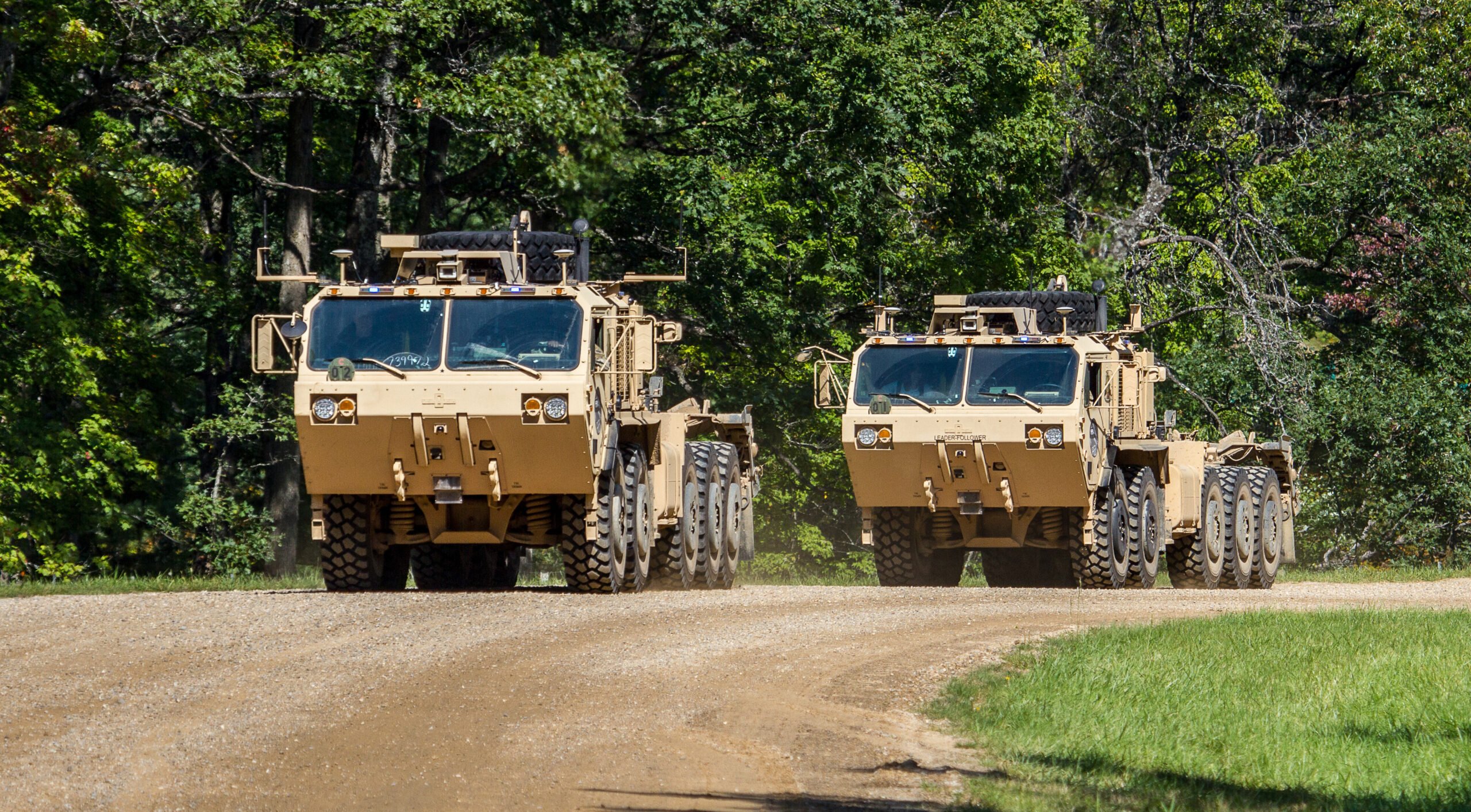Army closing down ‘leader-follower’ robotic truck development, eyeing commercial solutions

Oshkosh Palletized Loader System trucks equipped with Leader-Follower autonomy systems. (Oshkosh Defense)
WASHINGTON — After years of work to create autonomous truck convoys to keep Army soldiers out of harm’s way, the service said it’s winding down its internal development effort and is instead pursuing another acquisition path for the robotic driving kits — one that will rely on commercial solutions.
Roadside bomb attacks on Iraqi and Afghan roads nearly two decades ago helped propel the Army’s quest to create autonomy kits to install on transport trucks ferrying supplies and equipment around on the battlefield. In 2017 the service stood up of the Expedient Leader Follower (ExLF) operational test demonstration, to see if they could make that vision a reality.
Work on that development effort has been ongoing ever since with the Army Capabilities Development Command Ground Vehicle Systems Center (DEVCOM GVSC) orchestrating the project to include the government’s robotic technology kernel, Oshkosh Defense’s Palletized Load System trucks and Robotic Research Autonomous Industries’s autonomy kits, as well as DCS assisting with interface and communications.
But six years after the original demonstration kicked off, the Army told Breaking Defense it’s pulling the plug on its own leader-follower initiative, by way of awarding both Oshkosh Defense and Robotic Research deals in recent months to wind down the program. Robotic Research told Breaking Defense it received $53.1 million to cover the last 60-month sprint. An Oshkosh spokesperson didn’t respond to a request for comment by press time.
“This effort supports the closure of ExLF by returning the vehicle fleet back to a non-robotic truck to be returned to the force for use,” a spokeswoman for the Product Management Office for Robotic and Autonomous Systems inside the PEO Combat Support & Combat Service Support (PEO CS&CSS) told Breaking Defense on May 31.
She did not disclose just how many trucks will need to be returned to the original configuration, but as of 2021, the 41st Transportation Company had received 60 leader-follower systems for testing.
The closure of the internal leader-follower initiative means the tech already developed will not be shepherded through production, but the service still is eyeing a new acquisition pathway for robotic drivers as part of its Autonomous Transport Vehicle System (ATV-S). However, this time it is not looking to help develop the technology, but is instead searching directly for commercial options via a prototyping competition dubbed the Ground Expeditionary Autonomy Retrofit Systems, or GEARS, run through the Defense Innovation Unit on behalf of the Army.
“The government is seeking vendors that can take existing military vehicles — including subsystems, such as trailers — and enhance them for safe, reliable, robust uncrewed operations through hardware and software integration,” the DIU wrote in a recent post about the initiative. For the prototyping competition, the Army is seeking both hardware and software components, and everything must be able to deploy onto the Army’s Palletized Load System (PLS), and possibly other tactical wheeled vehicles.
“Solutions must have the ability to operate in environments inherent to military operations. Desired mission sets include, but are not limited to, convoy operations, waypoint navigation, and teleoperations,” the DIU post continues. “Solutions should be built to open architecture standards and be capable of integrating new hardware, software, and features as they become available.”
The Army wants to have responses back by mid-June, and any companies selected to participate with GEARS should be able to convert up to six vehicles within 12 months of contract award, and up to 50 or more vehicles within 30 months. If the program is a success, DIU noted that a winning team could walk away with a production contract.
While DEVCOM’s leader-follower development will not transition directly into an acquisition program, some of the fruits of that original investment could be propelled forward as at least one company on that contract, Robotic Research, says it wants to snag a spot on the GEARS prototyping competition.
“We’re excited that it’s a commercial solution offering and that PEO CS&CSS will have an opportunity to see what the commercial teams can bring to the defense autonomy space,” Scott Sanders, Robotic Research’s chief growth officer, told Breaking Defense on May 31.
The company said that its AutoDrive technology is Modular Open Systems Approach compliant to allow the government to deploy their own autonomy modules on top of the system.
The company is already doing autonomy work on a separate DIU contract for the Army’s Robotic Combat Vehicle effort under the Ground Vehicle Autonomous Pathways project. For that effort, the service wants to take soldiers out of smaller combat vehicles. Late last year Robotic Research, along with Applied Intuition, Kodiak Robotics, Neya Systems and Scale AI received contracts to make this happen.
Under that project, the trio are tasked with prototyping software for the navigation of uncrewed vehicles by fusing data from multiple sensors and allow for teleoperations of unmanned ground vehicles, according to an updated May announcement. Furthermore, it provides a “pipeline” to continue rapid development and deployment.
“There has been a revolution in the techniques and capabilities of uncrewed ground vehicles occurring in the private sector over the past two decades,” Kevin O’Brien, the technical director for DIU’s autonomy portfolio, said in a release about the small vehicle project. “We’re eager to bring these matured technologies back into the Department of Defense, where initial work was inspired by the DARPA Grand Challenges.”